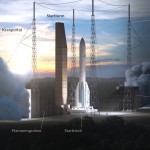Dann forschen Sie doch mit! Derzeit gibt es gleich zwei Möglichkeiten, sich aktiv in die Forschung auf dem Gebiet der Astronomie einzubringen. Die erste betrifft die ESA-Mission „Gaia“:
„Follow-up opportunity of a rare microlensing event: (…) In July and August 2016 the first microlensing events were detected. Microlensing happens when light rays from a distant star (we call this the source) are bent by the space-time curvature of an object (e.g. a star, a planet, or a black hole), lying exactly between the observer and the distant star. This hitherto unseen object is called the lens, and being closer to us, and moving faster across the sky, leads to a sometimes dramatic increase (and then decrease) in the brightness of the background source.
(…)
… the model predicts another sharp rise in brightness which is expected to happen in the first or second week of November 2016. We are currently waiting for the final predicted re-brightening, which will help solve the puzzle of the exact nature of the components of the binary system. Gaia16aye is the perfect example of the importance of ground-based follow-up of Gaia Alerts, carried out by professionals but also by amateur astronomers, which can make a huge scientific impact. Indeed, it would have been quite difficult to confirm Gaia16aye as a microlensing event without the extra follow-up, and certainly the binary nature of the lens, and constraints on the system components would be impossible.Gaia16aye is reasonably bright (currently of about 13th mag in I and 14th mag in V), and hence is observable even by some smaller telescopes operated by schools and amateur astronomers. Please contact Lukasz Wyrzykowski if you would like to get involved and collect more data on this event, or if you already have and would like to share your data with us.“
Quelle: http://www.cosmos.esa.int/web/gaia/IoW_20161027
Die zweite Einladung zur „Citizen Science“ kommt von der japanischen Raumfahrtagentur JAXA und betrifft deren Venus-Mission „Akatsuki“ im Zeitraum Oktober 2016 bis Januar 2017:
„We are delighted to announce a new website devoted to the collaboration and coordination between JAXA’s AKATSUKI mission to Venus and planetary ground-based observers. Since its arrival to Venus in December 2015, the japanese orbiter AKATSUKI has been performing regular observations towards its main goal: characterizing the atmospheric circulation of Venus. (…) In the AKATSUKI team we are aware of the high quality of present Venus observations from both professional and amateur observers, and we would like to invite you all to register in our website and join our next campaigns of coordinated observations of Venus. Observers can contribute directly to the mission by sharing your own images, spectra and other derived products, thus having the chance to participate as co-authors in those papers where donated ground-based data is decided to have quality enough to be used along with AKATSUKI data. The website can be found here: https://akatsuki.matsue-ct.jp/
Useful information about the AKATSUKI observations day-to-day is found here: https://akatsuki.matsue-ct.jp/?q=node/20
Summary of wavelengths of interest to observe Venus: https://akatsuki.matsue-ct.jp/sites/default/files/info/Levels_Sensed_Wavelengths_SIMPLER.png
Instructions to donate images of Venus (temporal until system of uploading is ready): https://akatsuki.matsue-ct.jp/…/HOWTO_Submit_Venus_Images.pdfPlease, help us to distribute this information through other forums of ground-based observers, and do not hesitate to get in touch with us through our official mail addresses: coordinatewithakatsuki@gmail.com coordinate@akatsuki.matsue-ct.jp„
Quelle: https://www.facebook.com/permalink.php?story_fbid=1339379642763154&id=124515220920764
Viel Spaß, viel Erfolg und Clear Skies!







Schreibe eine Antwort